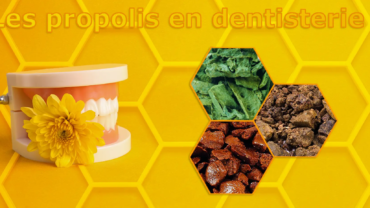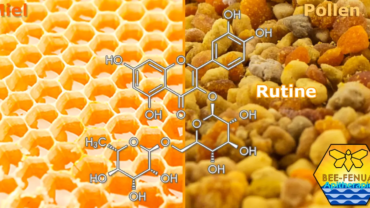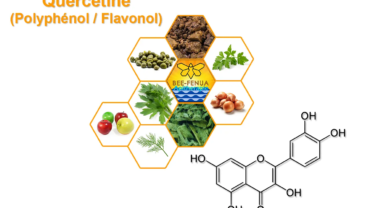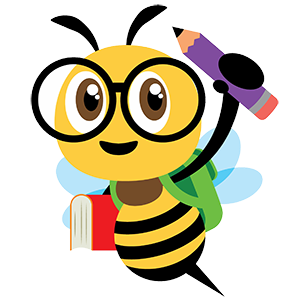Les références scientifiques
en apithérapie moderne
Les articles scientifiques
Les news en apithérapie
Articles sur l'apithérapie

La propolis a démontré une efficacité à inhiber la fixation, la croissance et le métabolisme des micro-organismes responsables de la formation du biofilm dentaire (le tartre).
Des études en laboratoire ont révélé que la propolis peut inhiber la production d’enzymes glycosyltransférases, essentielles à la formation du biofilm.

Rutine ou rutoside ? Le rutoside porte aussi les noms de rutine et sophorine. La rutine un flavonoïde de type Flavonol. La rutine est chimiquement…

Où trouve-t-on de la quercétine ? La quercétine est un flavonoïde polyphénolique classé dans les flavonols. On peut trouver de la quercétine dans : Certaines…
Liste des études scientifiques

- EFSA. – Beeswax (E901) as a glazing agent and a carrier for flavours. Scientific opinion of the pane on food additives, flavourings, processing aids and materials in contact with food (AFC). (2007)
- Tomczyk, M.; Zaguła, G.; D˙zugan, M. A simple method of enrichment of honey powder with phytochemicals and its potential application in isotonic drink industry. (2020)
- Fratini, F.; Cilia, G.; Turchi, B.; Felicioli, A. Beeswax: A minireview of its antimicrobial activity and its application in medicine. (2016)
- C. Nonotte-Varly. Les pollens allergisants de la gelée royale d’origine française. Revue française d’allergologie (2022)
- Almeida-Muradian et al. (2005). Chemical composition and botanical evaluation of dried bee pollen pellets.
- Anjos, O. et al. (2019). Influence of the storage conditions on the quality of bee pollen.
- Bakour, M. et al. (2019). Bee bread as a functional product: Chemical composition and bioactive properties.
- Cagno, R. et al. (2019). Novel solid-state fermentation of bee-collected pollen emulating the natural fermentation process of bee bread.
- Disayathanoowat, T et al. (2020). Different Dynamics of Bacterial and Fungal Communities in Hive-Stored Bee Bread and Their Possible Roles : A Case Study from Two Commercial Honey Bees in China.
- Jaya, F. et al. (2020). Antioxidant activity and microbiological quality of bee bread collected from three different species honey bee.
- Kieliszek, M. et al. (2018). Pollen and bee bread as new health-oriented products.
- Mohammad et al. (2020). Botanical Origin and Nutritional Values of Bee Bread of Stingless Bee (Heterotrigona itama) from Malaysia.
- Mohammad et al. (2021). Stingless Bee-Collected Pollen (Bee Bread) : Chemical and Microbiology Properties and Health Benefits.
- Vásquez, A., Olofsson, T. C. (2009). The lactic acid bacteria involved in the production of bee pollen and bee bread.
- Khalifa et al., 2020. Recent insights into chemical and pharmacological studies of bee bread.
- Rodica Mărgăoan 2019. Bee Collected Pollen and Bee Bread: Bioactive Constituents and Health Benefits.
- Castro H.J. – A phase I study of the safety of honeybee venom extract as a possible treatment for patients with progressive forms of multiple sclerosis. (2005)
- Ali, M.A.A.S.M. – Studies on bee venom and its medical uses (2012)
- Rady, I. et al. – Mellitin, a major peptide component of bee venom, and its conjugates in cancer therapy. (2017)
- Abdela, N. et aL. – Bee Venom and its Therapeutic Values (2016)
- Pucca, M.B.et al. – Current knowledge on bee venom and bee envenoming therapy. (2019)
- Magrioti, V.; Kokotos, G. – Phospholipase A2 inhibitors as potential therapeutic agents for the treatment of inflammatory diseases. (2010)
- Cherniack, E.P.; Govorushko, S. – To bee or not to bee : The potential efficacy and safety of bee venom acupuncture in humans. (2018)
- Jang, S.B.; Kim, K.H. – Clinical effectiveness and adverse events of bee venom therapy : A systematic review of randomized controlled trials. (2020)
- Lee, E.J.; Ahn, Y.C.; Kim, Y.I.; Oh, M.S.; Park, Y.C.; Son, C.G. – Incidence Rate of Hypersensitivity Reactions to Bee-Venom Acupuncture. (2020)
- Weis, W.A.; Ripari, N.; Conte, F.L.; da Silva Honorio, M.; Sartori, A.A.; Matucci, R.H.; Sforcin, J.M. – An overview about apitherapy and its clinical applications. (2022)
- Kim, K.; Jeong, H.; Lee, G.; Jang, S.; Yook, T. – Characteristics of Adverse Events in Bee Venom Therapy Reported in South Korea: A Survey Study. (2022)
- Hwang, Y.J.; Lee, B.C. – Clinical study of anaphylaxis on bee-venom acupuncture. (2000)
- Dhopeshwarkar, N.; Sheikh, A.; Doan, R.; Topaz, M.; Bates, D.W.; Blumenthal, K.G.; Zhou, L. – Drug-induced anaphylaxis documented in electronic health records. (2019)
- Burdock GA. – Review of the biological properties and toxicity of bee propolis (1998)
- S VKL. – Propolis in dentistry and oral cancer management. ( 2014)
- Khurshid Z, Naseem M, Zafar MS, Najeeb S, Zohaib S. – Propolis : A natural biomaterial for dental and oral healthcare (2017)
- Wilcko WM, Wilcko T, Bouquot JE, Ferguson DJ. – Rapid orthodontics with alveolar reshaping : two case reports of decrowding (2001)
- Raghukumar R, Vali L, Watson D, Fearnley J, Seidel V. – Antimethicillin resistant Staphylococcus aureus (MRSA) activity of « pacific propolis » and isolated 53 prenylflavanones. (2010)
- Huleihel M, Isanu V. – Anti-herpes simplex virus effect of an aqueous extract of Propolis (2002)
- Ito J, Chang FR, Wang HK, Park YK, Ikegaki M, Kilgore N, et al. – Anti-HIV activity of moronic acid derivatives and the new melliferonerelated triterpenoid isolated from Brazilian propolis. (2001)
- Harish Z, Rubinstein A, Golodner M, Elmaliah M, Mizrachi Y. – Suppression of HIV-1 replication by propolis and its immunoregulatory effect. (1997)
- Siqueira ABS, Rodriguez LRN de A, Santos RKB, Marinho RRB, Abreu S, Peixoto RF, et al. – Antifungal activity of propolis against Candida species isolated from cases of chronic periodontitis. (2015)
- Alves de Lima NC, Ratti BA, Souza Bonfim Mendonça P de, Murata G, Araujo Pereira RR, Nakamura CV, et al. – Propolis increases neutrophils response against Candida albicans through the increase of reactive oxygen species. (2018)
- Borrelli F, Maffia P, Pinto L, Ianaro A, Russo A, Capasso F, et al. – 54 Phytochemical compounds involved in the anti-inflammatory effect of propolis extract. (2002)
- Chan GC-F, Cheung K-W, Sze DM-Y. – The immunomodulatory and anticancer properties of propolis. (2013)
- Wu J, Omene C, Karkoszka J, Bosland M, Eckard J, Klein CB, et al. – Caffeic acid phenethyl ester (CAPE), derived from a honeybee product propolis, exhibits a diversity of anti-tumor effects in pre-clinical models of human breast cancer. (2011)
- Chuu C-P, Lin H-P, Ciaccio MF, Kokontis JM, Hause RJ, Hiipakka RA, et al. – Caffeic acid phenethyl ester suppresses the proliferation of human prostate cancer cells through inhibition of p70S6K and Akt signaling networks. (2012)
- Chen M-F, Wu C-T, Chen Y-J, Keng PC, Chen W-C. – Cell killing and radiosensitization by caffeic acid phenethyl ester (CAPE) in lung cancer cells. (2004)
- Kuo Y-Y, Jim W-T, Su L-C, Chung C-J, Lin C-Y, Huo C, et al. – Caffeic Acid Phenethyl Ester Is a Potential Therapeutic Agent for Oral Cancer. (2015)
- Bretz WA, Chiego DJ, Marcucci MC, Cunha I, Custódio A, Schneider LG. – Preliminary report on the effects of propolis on wound healing in the dental pulp. (1998)
- Arenberger P, Arenbergerova M, Hladíková M, Holcova S, Ottillinger B. – Comparative Study with a Lip Balm Containing 0.5% Propolis Special Extract GH 2002 versus 5% Aciclovir Cream in Patients with Herpes Labialis in the Papular/Erythematous (2018)
- Mazia RS, de Araújo Pereira RR, de Francisco LMB, Natali MRM, Dias Filho BP, Nakamura CV, et al. – Formulation and Evaluation of a Mucoadhesive Thermoresponsive System Containing Brazilian Green Propolis for the Treatment of Lesions Caused by Herpes Simplex Type I. (2016)
- Curra M, Soares Junior LAV, Martins MD, Santos PS da S. – Chemotherapy protocols and incidence of oral mucositis. An integrative review. (2018)
- Piredda M, Facchinetti G, Biagioli V, Giannarelli D, Armento G, Tonini G, et al. – Propolis in the prevention of oral mucositis in breast cancer patients receiving adjuvant chemotherapy : A pilot randomised controlled trial. (2017)
- Eslami H, Pouralibaba F, Falsafi P, Bohluli S, Najati B, Negahdari R, et al. – Efficacy of Hypozalix spray and propolis mouthwash for prevention of chemotherapyinduced oral mucositis in leukemic patients: A double-blind randomized clinical trial. (2016)
- Joshy A, Doggalli N, Patil K, Kulkarni PK. – To Evaluate the Efficacy of Topical Propolis in the Management of Symptomatic Oral Lichen Planus : A RandomizedControlled Trial. (2018)
- Salehi M, Motallebnejad M, Moghadamnia AA, Seyemajidi M, Khanghah SN, Ebrahimpour A, et al. – An Intervention Airing the Effect of Iranian Propolis on Epithelial Dysplasia of the Tongue : A Preliminary Study. (2017)
- Burdock GA. – Review of the biological properties and toxicity of bee propolis (1998)
- S VKL. – Propolis in dentistry and oral cancer management. ( 2014)
- Khurshid Z, Naseem M, Zafar MS, Najeeb S, Zohaib S. – Propolis : A natural biomaterial for dental and oral healthcare (2017)
- Oliveira AV, Ferreira AL, Nunes S, Dandlen SA, Miguel da G da G, Faleiro – Antibacterial activity of propolis extracts from the south of Portugal. (2017)
- Wilcko WM, Wilcko T, Bouquot JE, Ferguson DJ. – Rapid orthodontics with alveolar reshaping : two case reports of decrowding (2001)
- Raghukumar R, Vali L, Watson D, Fearnley J, Seidel V. – Antimethicillinresistant Staphylococcus aureus (MRSA) activity of « pacific propolis » and isolated 53 prenylflavanones. (2010)
- Huleihel M, Isanu V. – Anti-herpes simplex virus effect of an aqueous extract of Propolis (2002)
- Ito J, Chang FR, Wang HK, Park YK, Ikegaki M, Kilgore N, et al. – Anti-HIV activity of moronic acid derivatives and the new melliferonerelated triterpenoid isolated from Brazilian propolis. (2001)
- Harish Z, Rubinstein A, Golodner M, Elmaliah M, Mizrachi Y. – Suppression of HIV-1 replication by propolis and its immunoregulatory effect. (1997)
- Siqueira ABS, Rodriguez LRN de A, Santos RKB, Marinho RRB, Abreu S, Peixoto RF, et al. – Antifungal activity of propolis against Candida species isolated from cases of chronic periodontitis. (2015)
- Alves de Lima NC, Ratti BA, Souza Bonfim Mendonça P de, Murata G, Araujo Pereira RR, Nakamura CV, et al. – Propolis increases neutrophils response against Candida albicans through the increase of reactive oxygen species. (2018)
- Borrelli F, Maffia P, Pinto L, Ianaro A, Russo A, Capasso F, et al. – 54 Phytochemical compounds involved in the anti-inflammatory effect of propolis extract. (2002)
- Chan GC-F, Cheung K-W, Sze DM-Y. – The immunomodulatory and anticancer properties of propolis. (2013)
- Wu J, Omene C, Karkoszka J, Bosland M, Eckard J, Klein CB, et al. – Caffeic acid phenethyl ester (CAPE), derived from a honeybee product propolis, exhibits a diversity of anti-tumor effects in pre-clinical models of human breast cancer. (2011)
- Chuu C-P, Lin H-P, Ciaccio MF, Kokontis JM, Hause RJ, Hiipakka RA, et al. – Caffeic acid phenethyl ester suppresses the proliferation of human prostate cancer cells through inhibition of p70S6K and Akt signaling networks. (2012)
- Chen M-F, Wu C-T, Chen Y-J, Keng PC, Chen W-C. – Cell killing and radiosensitization by caffeic acid phenethyl ester (CAPE) in lung cancer cells. (2004)
- Kuo Y-Y, Jim W-T, Su L-C, Chung C-J, Lin C-Y, Huo C, et al. – Caffeic Acid Phenethyl Ester Is a Potential Therapeutic Agent for Oral Cancer. (2015)
- Bretz WA, Chiego DJ, Marcucci MC, Cunha I, Custódio A, Schneider LG. – Preliminary report on the effects of propolis on wound healing in the dental pulp. (1998)
- Arenberger P, Arenbergerova M, Hladíková M, Holcova S, Ottillinger B. – Comparative Study with a Lip Balm Containing 0.5% Propolis Special Extract GH 2002 versus 5% Aciclovir Cream in Patients with Herpes Labialis in the Papular/Erythematous (2018)
- Mazia RS, de Araújo Pereira RR, de Francisco LMB, Natali MRM, Dias Filho BP, Nakamura CV, et al. – Formulation and Evaluation of a Mucoadhesive Thermoresponsive System Containing Brazilian Green Propolis for the Treatment of Lesions Caused by Herpes Simplex Type I. (2016)
- Curra M, Soares Junior LAV, Martins MD, Santos PS da S. – Chemotherapy protocols and incidence of oral mucositis. An integrative review. (2018)
- Piredda M, Facchinetti G, Biagioli V, Giannarelli D, Armento G, Tonini G, et al. – Propolis in the prevention of oral mucositis in breast cancer patients receiving adjuvant chemotherapy : A pilot randomised controlled trial. (2017)
- Eslami H, Pouralibaba F, Falsafi P, Bohluli S, Najati B, Negahdari R, et al. – Efficacy of Hypozalix spray and propolis mouthwash for prevention of chemotherapyinduced oral mucositis in leukemic patients: A double-blind randomized clinical trial. (2016)
- Joshy A, Doggalli N, Patil K, Kulkarni PK. – To Evaluate the Efficacy of Topical Propolis in the Management of Symptomatic Oral Lichen Planus : A Randomized Controlled Trial. (2018)
- Salehi M, Motallebnejad M, Moghadamnia AA, Seyemajidi M, Khanghah SN, Ebrahimpour A, et al. – An Intervention Airing the Effect of Iranian Propolis on Epithelial Dysplasia of the Tongue : A Preliminary Study. (2017)
- Abd El Hady F. K, and Hegazi AG., (2002) – Egyptian Propolis : Chemical Composition, Antiviral and Antimicrobial Activities of East Nile Delta Propolis.
- Antonio S, Erica W. T, Giuseppina N, Dejair M., (2005) – Origin and Chemical Variation of Brazilian propolis.
- Association Française des Enseignants de chimie Thérapeutiques (AFECT)., (2003) – Médicaments antitumoraux et perspectifs dans le traitement des cancers.
- Bankova V. S, De Castro S. L, Marcucci M. C., 2000. Propolis: recent advance in chemistry and plant origin.
- Bankova V, Popova M, Dogdanov S, Sahatini A G., 2002. Chemical composition of European propolis : Expected and Unexpected Results.
- Bankova V., 2005. Recent trends and important developments in propolis research.
- Behling KB,. Se.ndiio M.C, Heloisa D.C. Francescnto .H D.C, Antunes L M.G , Costa R S, .Bianchi M. L. P., 2006. Comparative study of multiple dosage of quercetin against cisplatin-induced nephrotoxicity and oxidative stress in rat kidneys.
- Borbulevych O.Y, Jankun J.; Selman S.H., 2004. Skrzypczak-Jankun, E. Lipoxygenase interactions with natural flavonoid, quercetin, reveal a complex with protocatechuic acid in its X-ray structure at a resolution. Proteins.
- Conklin KA, et al., 2004. Chemotherapy-associated oxidative stress: impact on chemotherapeutique effectiveness.
- Cuvelier C, Iotreppe, Istasse L., 2003. Chimie, sources alimentaires et dosage de la vitamine E.
- Fiorucci S., 2006. Activité biologique de composés de la famille des flavonoïdes : approches par des méthodes de la chimie quantique et de dynamique moléculaire.
- Ghuysen M.S., 2005. Les médicaments dangereux pour le rein.
- Gonwales R, Corcho .l, Remirez D, Rodriguez S, Ancheta 0, Merino N, Gonzales A, and Pascual C., 1995. Hepathoprotective effects of propolis extract on carbon tetrachlorideinduced liver injury in rats.
- Isla M., Moreno M, Sampitro A, and Vattune M. A., 2001. Antioxdant actvity of argentina propolis extract.
- Janero D. R., 1990. Malondaldehyde and thiobar’bituric acid-reactivity as dianostic of lipid peroxydation and peroxydative injury.
- Januel C., 2003. Stress oxydant au niveau des plaquettes sanguines humaines dans le contexte du diabète. Etude du glutathion et de la glutathion peroxydase 4.
- Katircioglu H and Mercan N., 2006. Antimicrobial activity and chemical compositions of Turkish propolis from different regions.
- Kumazawa S, Hamasaka T, Nakayama T., 2004. Antioxidant activity of propolis of various geographic origins.
- Lahouel M., 2005. Interaction flavonoides-mitochondrie et rôle de la propolis dans la prévention de l’apoptose induite pat certains médicaments anticancéreux.
- Marcucci, M.C. 1995. Propolis : chemical composition, biological properties and therapeutic activity.
- Milan H., 2004. La quercetine et ses dérivés : molécules à caractère prooxydant ou capteurs de radicaux libres; études et applications thérapeutiques.
- Neiva-Moreno MI. N, Isla M. I, Sampietro A. R, and Vattuone M.A., 2000. Comparaison of the free radical-scavenging activity of propolis from several regions in Argentina.
- Sawaya. A. C.H.F, Palma M. A, Caetano F. M, Marcucci M. C, da Silva Cunha I.B, Araujo. CE. P and Shimizu M.T., 2002. Comparative study of in vitro methods used to analyse the activity of propolis extracts with different compositions agains species of Candida.
- Sharma M, Pillai K. K, Husain S. Z, Giri D. K.,1997. Protective role of propolis against alcohol carbon tetrachlorde-induced hepatotoxicity in rats.
- Sun F, Hayarni S, Haruna S, Ogiri Y, Tanaki K, Yarnada Y, Ikeda K, Yarnada H, Kawai N and Kojo S., 2000. ln vivo antioxydative activity of propolis evaluated by the interaction with vitamin C and vitamin E and the levet of lipid hydroperoxides in rats.
- Zhou J., Wang, L, Wang J, Tang, N., 2001. Antioxidative and antitumour activities of solid quercetin metal (II) complexes.
- Alvarez-Suarez, J.M., 2017. Bee products – chemical and biological properties.
- Tilahun, B., Faust, A.C., McCorstin, P., Ortegon, A., 2015. Nasal colonization and lower respiratory tract infections with methicillin-resistant Staphylococcus aureus.
- Silici, S., Kutluca, S., 2005. Chemical composition and antibacterial activity of propolis collected by three different races of honeybees in the same region.
- Morroni and Al. – 2018. Comparison of the antimicrobial activities of four honeys from three countries (New Zealand, Cuba, and Kenya).
- Alotibi and Al. – 2018. Floral markers and biological activity of Saudi honey.
- Chen, Y., Ye, S., Ting, C., Yu, Y. – 2017. Antibacterial activity of propolins from Taiwanese green propolis.
- Szczurek, A and Al. – Gas sensor array and classifiers as a means of varroosis detection. Sensors 2020,
- Andrzej Szczurek and Monika Maciejewska – 2021 – Beehive Air Sampling and Sensing Device Operation in Apicultural Applications—Methodological and Technical Aspects
- W. G. Meikle & N. Holst – 2015 – Application of continuous monitoring of honeybee colonies.
- Anna Kurek-Górecka et al. (2020) Bee Products in Dermatology and Skin Care
- Goharshenasan P et al. Topical application of honey on surgical wounds – A randomized clinical trial. ( 2016)
- Komosinska-Vassev, Ket al. Bee pollen : Chemical composition and therapeutic application. (2015)
- Olczyk, P et al. – Propolis modifies collagen types I and III accumulation in the matrix of burnt tissue. (2013)
- Hozzein W et al. Topical application of propolis enhances cutaneous wound healing by promoting TGF-beta/smad-mediated collagen production in a streptozotocin-induced type I diabetic mouse model. (2015)
- Abouda Z. et al. – The antibacterial activity of Moroccan bee bread and bee pollen (fresh and dried) against pathogenic bacteria. (2011)
- Han S.M. – Skin sensitization study of bee venom (Apis mellifera L.) in guinea pigs. (2012)
- Kurek-Górecka, A et al. – Structure and antioxidant activity of polyphenols derived from propolis. Molecules (2013)
- Olczyk P. et al. – Free radical scavenging activity of drops and spray containing propolis—An EPR examination. (2017)
- Isidorov V.A. et al. – Gas chromatographic–mass spectrometric investigation of the chemical composition of beebread. (2009)
- Sugiyama T. – Royal jelly acid, 10-hydroxy-trans-2-decenoic acid, as a modulator of the innate immune responses. (2012)
- Fratini F. et al. – Beeswax: A minireview of its antimicrobial activity and its application in medicine. (2016)
- Son D.J. et al. – Therapeutic application of anti-arthritis, pain-releasing, and anti-cancer effects of bee venom and its constituent compounds. (2007)
- Pałgan K. et al. – Biological properties of bee venom. (2009)
- Kim H. et al. – Potential therapeutic applications of bee venom on skin disease and its mechanisms (2019)
- Han S.M. et al. – Evaluation of the skin phototoxicity and photosensitivity of honeybee venom. (2017)
- Kedzia B. et al. – Contemporary opinions on the mechanism of antimicrobial action of honey. (2017)
- Nordin A. et al. – Honey epithelial to mesenchymal transition in wound healing (2017)
- Minden-Birkenmaier B.A. et al. – Honey-based templates in wound healing and tissue engineering (2018)
- Al-Waili N. et al. – Propolis and bee venom in diabetic wounds; a potential approach that warrants clinical investigation. (2015)
- Amoros M. et al. – Synergistic effect of flavones and flavonols against herpes simplex virus type 1 in cell culture. Comparison with the antiviral activity of propolis. (1992)
- Nolkemper S. et al. – Mechanism of herpes simplex virus type 2 suppression by propolis extracts. (2010)
- Peng L. et al. – Antifungal activity and action mode of pinocembrin frompropolis against Penicillium italicum. (2012)
- Koo H. et al. – Effects of compounds found in propolis on Streptococcus mutans growth and on glucosyltransferase activity. (2002)
- Kedzia B. – Propolis in the treatment of dental caries. (2011)
- Bucekova M. et al. – Bee-derived antibacterial peptide, defensin 1, promotes wound re-epithelialisation in vitro and in vivo. (2017)
- Kasparaviciene G. et al. – Evaluation of beeswax influence on physical properties of lipstick using instrumental and sensory methods. (2016)
- Ahad A. et al. – Chrysin, an anti-inflammatory molecule, abrogates renal dysfunction in type 2 diabetic rats. (2014)
- Han S.M. et al. – Effects of cosmetics conatining purified honeybee (Apis mellifera L.) venom on acne vulgaris. (2013)
- You C.E. et al. – Effects of emollient containing bee venom on atopic dermatitis : A double-blinded, randomized, base-controlled, multicenter study of 136 patients. (2016)
- Prakash S. et al. – Apis cerana bee venom : It’s antidiabetic and anti-dandru activity against malassezia furfur. (2014)
- Han S.M. et al. – The beneficial effects of honeybee-venom serum on facial wrinkles in humans. (2015)
- Elieh Ali Komi D. et al. – Immunology of Bee Venom. (2018)
